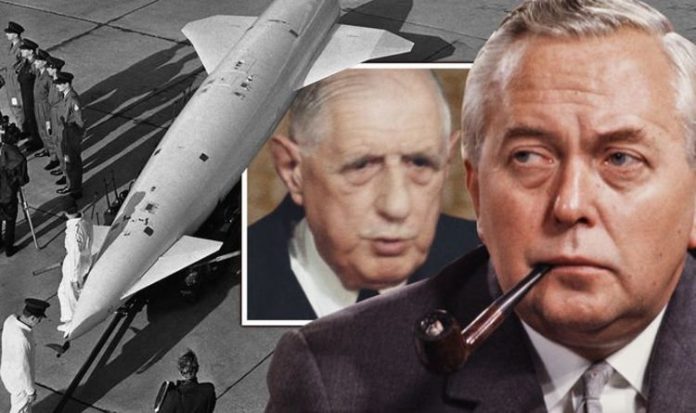USAF lost nuclear missile in the sea reveals documentary
The move came during the Sixties – at the height of the Cold War – as the US and Soviet Union battled it out to be the ultimate superpower on the ground and in space. Both nations had already tested several nuclear weapons and other countries – including Britain and France – were eager to get a slice of the action too. Papers from 1967 show that Mr Wilson approached former French President Charles de Gaulle for a meeting to discuss the possibility of working together on a separate nuclear agreement should Britain be accepted into the EEC, the EU’s precursor.
The brief reads: “Our first two POLARIS submarines have already been launched.
“We plan that all four should be operational by December 1969.
“We are taking steps to ensure that our POLARIS missiles will remain as effective weapons if the Russians complete their deployment of an ABM system.
“We have, however, decided not to buy the POSEIDON missile or to embark on the development of a new generation of nuclear weapons in co-operation with the US.”

Harold Wilson wanted to join the EEC (Image: GETTY)

Harold Wilson was UK Prime Minister (Image: GETTY)
The UGM-73 POSEIDON missile was the second US Navy nuclear-armed submarine-launched ballistic missile (SLBM) system, powered by a two-stage solid-fuel rocket.
However, Mr Wilson was seemingly uninterested in this weapon and wanted to use the UK’s position as a nuclear power to gain entry to the EEC.
His brief continued: “In a few year’s time, therefore, our military nuclear relationship with the US, as it has existed since Nassau, will probably be coming to an end.
“We may then face a choice between renewing such nuclear cooperation with the US or developing our nuclear policy in a primarily European context.
“How this decision moves [forward] is bound to be determined largely by the possibilities presented to Britain of a fuller participation in Europe’s economic and political developments.”
READ MORE: WW3 fears: Navy told to ‘pull punches’ after Soviet submarine ‘humiliated’ in UK waters

Charles de Gaulle blocked the UK’s entry to the EEC (Image: GETTY)
Mr Wilson, then, appeared to be hinting that he could share the UK’s nuclear secrets with the bloc – but his efforts were in vain.
General de Gaulle – who served as President of France from 1959 to 1969 – said “non” to Britain’s EEC membership application later in 1967, humiliating Mr Wilson in the process.
It came four years after his first veto, when it was Harold Macmillan he rejected with repeated references to Britain’s insular and maritime status.
Britain, he argued, was not European enough and had “in all her doings very marked and very original habits and traditions”.
He added: “In short, the nature, the structure, the very situation that are England’s differ profoundly from those of the continentals.”
DON’T MISS:
Tehran’s war capability revealed amid tensions with West [ANALYSIS
US soldier risked ‘cataclysmic outcome’ with defection to USSR [COMMENT]
Turkey close to Russia’s grasp amid Trump fury after Venezuela ruling [ANALYSIS]

Britain was rejected from the EEC again in 1967 (Image: GETTY)
The EEC was formed at the Treaty of Rome on March 24, 1957 – with Belgium, West Germany, France, Italy, Luxembourg and the Netherlands making up the original six signatures.
But the UK’s Commonwealth ties, domestic agricultural policy, and close links to the US were considered a problem for de Gaulle.
It was not until the Gallic icon passed away in 1970 that the UK was free to sign up to the bloc.
Former Prime Minister Edward Heath successfully took the UK into the EEC on January 1, 1973.
The UK would go on to scrap Mr Wilson’s plans and develop Chevaline – a system to update and improve the POLARIS capabilities.

Prime Minister Edward Heath successfully signed the UK up to EEC on January 1, 1973 (Image: GETTY)
The Trident nuclear programme was launched in 1979 as an operational system of four Vanguard-class submarines armed with US Trident D5 missiles.
Today, the Trident nuclear programme is still active, and its purpose as stated by the Ministry of Defence is to “deter the most extreme threats to our national security and way of life, which cannot be done by other means”.
It is operated by the Royal Navy and based at Clyde Naval Base on the west coast of Scotland, 25 miles from Glasgow.
At least one submarine is always on patrol to provide a continuous at-sea capability.
Each one carries up to eight missiles and 40 warheads, although their capacity is much larger.







